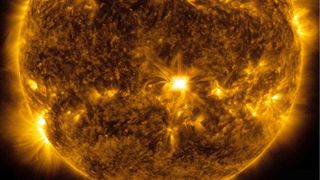Pew! Pew! Sun blasts two moderate solar flares in time for Star Wars Day
The Force-like sunspot will become 'increasingly geoeffective,' but auroras are not forecast for now.
While our sun merrily blasted two moderate-size solar flares in time for Star Wars Day, auroras are likely not our destiny yet.
NASA's Solar Dynamics Observatory recorded two M-class outbursts that peaked on Tuesday (May 3) at 8 p.m. EDT (0000 GMT on May 4) and on Wednesday (May 4) at 5 a.m. EDT (0900 GMT). Earth wasn't quite in firing range of the stellar-sized cannon, so it's unlikely we'll see a sky show.
The culprit was a new sunspot called AR3004, which also sent off a larger X-class explosion on the limb of the sun earlier on Tuesday. It is rotating within range of Earth, and will be "increasingly geoeffective" as it points towards our planet, SpaceWeather.com stated.
Related: The sun's wrath: Worst solar storms in history

NASA did not give specific guidance about the event, beyond its usual warnings about the possible effects of auroras affecting power lines and other infrastructure. The Space Weather Prediction Center, an office within the National Oceanic and Atmospheric Administration (NOAA) recorded a moderate radio blackout for the early-morning flare.
"Additional M-class flares remain likely, with a chance of X-class activity," the NOAA space weather forecast stated early Wednesday.
Generally, auroras may increase following a solar flare if charged particles from a coronal mass ejection move towards Earth. These particles flow along magnetic field lines of our planet and interact with the upper atmosphere, exciting air molecules and creating the colorful lights.
Get the Space.com Newsletter
Breaking space news, the latest updates on rocket launches, skywatching events and more!
The sun is coming off a very active April, with huge groups of sunspots and numerous flares ranging from moderate-sized to the largest X-class sized. Its forecasted peak is in 2025.
Both NASA and NOAA monitor the sun 24/7 to learn more about solar weather and possible effects on the Earth. NASA also operates the Parker Solar Probe mission, which is probing the ultra-hot upper atmosphere of the sun.
Follow Elizabeth Howell on Twitter @howellspace. Follow us on Twitter @Spacedotcom or on Facebook.
Join our Space Forums to keep talking space on the latest missions, night sky and more! And if you have a news tip, correction or comment, let us know at: community@space.com.

Elizabeth Howell (she/her), Ph.D., is a staff writer in the spaceflight channel since 2022 covering diversity, education and gaming as well. She was contributing writer for Space.com for 10 years before joining full-time. Elizabeth's reporting includes multiple exclusives with the White House and Office of the Vice-President of the United States, an exclusive conversation with aspiring space tourist (and NSYNC bassist) Lance Bass, speaking several times with the International Space Station, witnessing five human spaceflight launches on two continents, flying parabolic, working inside a spacesuit, and participating in a simulated Mars mission. Her latest book, "Why Am I Taller?", is co-written with astronaut Dave Williams. Elizabeth holds a Ph.D. and M.Sc. in Space Studies from the University of North Dakota, a Bachelor of Journalism from Canada's Carleton University and a Bachelor of History from Canada's Athabasca University. Elizabeth is also a post-secondary instructor in communications and science at several institutions since 2015; her experience includes developing and teaching an astronomy course at Canada's Algonquin College (with Indigenous content as well) to more than 1,000 students since 2020. Elizabeth first got interested in space after watching the movie Apollo 13 in 1996, and still wants to be an astronaut someday. Mastodon: https://qoto.org/@howellspace
